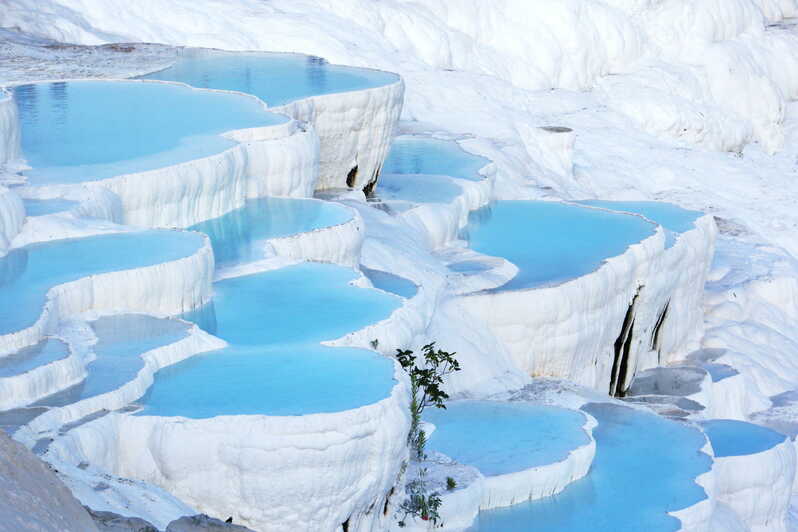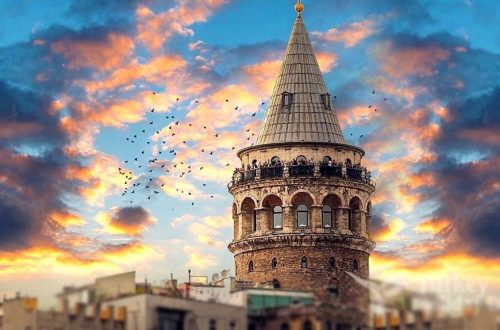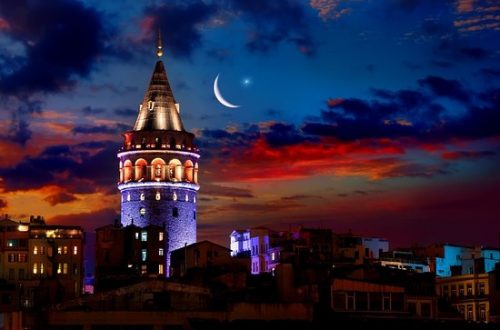
Pamukkale
Pamukkale & Hierapolis: (limestone terraces, travel tips)
The limestone terraces in Pamukkale, along with the ruins of Hierapolis, are among the most well-visited attractions in Turkey.
Because there is very little information about Pamukkale at a glance, I wrote a daily guide for Pamukkale-Hierapolis.
1. My tips for visiting Pamukkale-Hierapolis
Day trips to Pamukkale-Hierapolis are available from all the seaside resorts, Cappadocia and Istanbul.
The bus excursions cost € 50 to € 70, including entrance tickets and lunch.
Usually, day trips include the Pamukkale-Hierapolis ticket. You should check that out before you leave.
Otherwise, be sure to bring Turkish Lira with you!
Only Turkish lira are accepted at the entrance to Pamukkale: so be sure to exchange euros for Turkish lira beforehand!
Arrival: Pamukkale is located near the megacity Denizli, in southwest Anatolia.
The large seaside resorts on the south coast are about the same distance from Pamukkale. From Antalya, Bodrum, Kemer or Marmaris the journey takes 3 to 3 1/2 hours.
All you have to do is sit on the bus from Alanya or Side for 4 to 5 hours.
The local tour operators have recognized this problem: That is why they offer inexpensive two-day excursions which include hotel accommodation and food.
2. A day in Pamukkale-Hierapolis: What to see and do
Pamukkale is the most talked about attraction in Turkey.
This is due to the high number of visitors, the catchphrase “mass tourism” and natural sins from the past.
That makes the snow-white limestone terraces for some the most beautiful natural sights in Turkey, while for others, Pamukkale is a synonym for mass tourism.
I’ll go into that in more detail.
Pamukkale means “cotton castle”
The name is a great way to describe the water basins created from calcareous thermal water.
You can see the following in Pamukkale:
The snow-white limestone terraces of Pamukkale, the Cleopatra Pool, the Hierapolis Museum …
… and of course the ruins of the Roman-Byzantine city of Hierapolis with its mighty theatre.
Entrance through the Roman South Gate: (Entrance to the thermal springs and ruins)
The visitor entrance for the limestone terraces and ruins of Hierapolis is at the old south gate of the city.
There are parking spaces for the tour operators’ buses right next to the ticket counters.
If you arrive with your own car, you have to park it a little bit farther away, i.e. off the beaten track.
There are a few roofed souvenir stands, ice cream vendors, and other odds and ends for sale at the ticket counters.
This is your last chance to buy a cheap bottle of drinking water.
You will need at least two hours for a tour of the entire ruins. So pack some provisions!
After the turnstile at the entrance, you go straight to the Roman south gate of Hierapolis. Like many centuries ago, it is the entry point to Hierapolis and the limestone terraces of Pamukkale.
The path splits right after the gate. It will lead you to the limestone terraces on the left. On the right side of the path you will see one of the most impressive buildings from ancient Hierapolis.
It is the city’s theatre, built 1,900 years ago. It provided seating space for 15,000 people.
The 36 ° warm thermal water in the limestone terraces of Pamukkale
The limestone terraces made Pamukkale famous. They are also the reason why opinions about Pamukkale vary so widely.
Ten years ago, all visitors were allowed to walk on the limestone terraces with street shoes.
View from the upper side of the limestone terraces in Pamukkale with the thermal water flowing down and the people bathing in it
From here, you can only go barefoot to the limestone basin
From Pamukkale, below the terraces, a road has been dug through the limestone terraces.
There were hotels on the upper side. They weren’t too careful about wastewater.
At that time the terraces took on a greyish colour due to the dirt. Pamukkale was on the verge of losing its World Heritage status.
Authorities only reacted to the grievances after a threat from UNESCO.
Since then, the road has been dismantled and the hotels have disappeared.
Street shoes are forbidden on the limestone terraces. This has contributed to the rest of the fact that the “cotton castle” is as white as it once was.
For the same reason, you are only allowed to enter the limestone terraces of Pamukkale in one place.
It is the place where the road used to lead up the hill. In order to restore the landscape, artificial limestone basins have been created.
You are not allowed to enter any other area of the approximately two-kilometer-long limescale. This is now monitored by security forces. They stand every few hundred meters along the terraces.
You may only enter the limestone terraces barefoot
You can take off your shoes at the entrance to the limestone terraces. You can do that on comfortable park benches.
A wooden walkway leads from there to the terraces. From the footbridge, you walk ten meters to the first lime basin.
The pools are knee-deep filled with the turquoise-blue thermal water. It has a pleasant temperature of 36 °.
You can walk almost the entire length of the former road to Pamukkale.
There are pools of water every few meters in which you can bathe your feet. You should be careful while walking. Some places can be pretty smooth and slippery.
Only children can swim in the lime pools!
If you want to swim yourself there are two options:
You can swim in tthe Cleopatra Pool or the lake filled with thermal water at the foot of the hill.
3. Swimming in the Cleopatra Pool: (The ancient Roman baths)
You walk ten minutes from the limestone terraces to the Cleopatra Pool. It stands between the ruins of the Temple of Apollo, the Nymphaeum and the Great Bath of Hierapolis.
The baths attracted people from all over the Mediterranean as far back as Roman times. The city’s thermal water already had a reputation for alleviating various diseases.
Unfortunately, only the foundation walls and a few columns of the original baths have been preserved.
They were destroyed by an earthquake in the 7th century. At that time, the earth also subsided a little. This created the trough in which the pool water collects.
There are changing rooms next to the pool for changing. You can lock your things in a locker.
It’s fun to do a few laps in the pool and think about the history. You can see the amphitheatre, the nymphaeum and the ruins of the Apollo temple between the shady trees.
The crystal clear water in the pool has the same pleasant temperature as the limestone terraces. You can stand in the water almost anywhere. There are deep water holes only on the right edge.
The only thing that bothered me was the typical “beach music” from the speakers. I’m not exactly into it.
I didn’t fully use the two-hour ticket for the pool. I get bored quickly when swimming.
I was also drawn to the theatre on the nearby hill. It is only 10 minutes away from the pool changing rooms.
4. The ruins of the ancient city of Hierapolis
The oldest structures in the ruins are 2,200 years old. At that time the city was built as a kind of fortress.
Hierapolis first earned its reputation as a city of healing and thermal bathing during the Roman Empire.
All of the magnificent buildings that have been preserved date back to this period.
The closest structure to the Cleopatra Pool is the Apollo Temple. It stands behind the trees that separate the pool from the ruins.
The temple is one of the best preserved buildings in the city. Almost all the walls and the stairs to the altar are still intact.
Still more interesting is the view from the Temple of Apollo to the Hierapolis Theatre.
The Hierapolis Theatre is great!
It is incredible to imagine that people created this structure 1,900 years ago …
… so many generations have been around for a long time.
To get to the entrance of the theatre, you have to go up the hill from behind. You can get access to the upper side of the grandstands.
The first thing I did after the entrance was to sit on the top row of seats in the theatre. From the top rows of the seats, you also have a wonderful view of Hierapolis and the limestone terraces of Pamukkale.
It’s only from there that you realize how big they actually are. The snow-white limestone deposits stretch from south to north for more than two kilometres.
You can, of course, go down the stairs from above. They are pretty steep, just like in every theatre I’ve seen so far. I always ask myself whether people slid down the stairs.
Unfortunately, you cannot go all the way down to the stage. The area is partitioned off. I have no idea why. There is little to see there either. The statues that were once from the area have all been brought to the Hierapolis Museum.
You can find the museum between the Cleopatra Pool and the limestone terraces.
The grave of Apostle Philip
There are other ruins beyond the theatre. They are connected to the main road through Pamukkale by a large staircase and a private path. A gravel road leads from the amphitheatre to his grave.
The ruins belong to a church from the time of the Byzantine Empire. The apostle Philip is said to be buried in it.
Along the way to the tomb, you will pass the old city walls of Hierapolis. They are still easy to spot in the landscape.
It was there that I saw a few animals run through the ruins for the first time. A well camouflaged rock lizard ran along the walls. A tortoise was hiding in the grass next to the gravel road.
Philip’s Church of the Holy Sepulchre is not that interesting. There is only a small inscription and an old stone grave with the appropriate description.
The little things along the way were more exciting. In spring, red flowers bloom everywhere in Pamukkale.
I’m not exactly sure which flowers they are. It’s probably corn poppy. But I don’t need to know. I studied microbiology and not botany.
The flowers definitely go perfectly with the rugged landscape of Anatolia and the ruins of Hierapolis.
You can see all the other parts of the ruins very well from the church.
Paragliders in Hierapolis
Just above the hill on which the church stands, paragliders regularly launch into the valley. On their route into the valley, they fly 50 meters above the church ruins.
I heard them speak to their tandem partners:
Sometimes there was a screech. I’m not sure if it was pure panic or great joy.
Next, I made my way to the Northern Limestone Terraces. You looked too interesting from above.
The path first leads down a large stone staircase. There are some old stone sarcophagi on their sides. After a small bridge at the end of the stairs, it turns into a cobblestone street. To the left and right, it is separated from the foundations of old houses.
Small side streets lead to the ruins on both sides of the street. I went on through one of them.
Red flowers bloom everywhere, like in all other parts of the ruins, both beside and on the old paths.
The limestone terraces in the north of Pamukkale
You walk 15 minutes from the apostle’s grave to the limestone terraces in the north. They are just as interesting as the other pools, even though they are not filled with water.
The water is drained off by a stream on the limestone terraces. I have no idea why this is being done.
The route of the tandem paragliders leads along this part of the ruins. Again, you are only on the move at a height of 50 to 100 meters. Your initial fear has obviously dissolved into fun after the long flight. Instead of screeching, I often heard “Yeahhh – Woohoo hoho”.
A path leads along the limestone terraces to the north of the limestone terraces of Pamukkale. It will take you out of the ruins of the city through the well-preserved Roman north gate.
Behind it you can see the last foothills of the limestone deposits and the necropolis (tombs) of Hierapolis begin.
Necropolis: The city of the dead of Hierapolis
The Hierapolis necropolis is two to three kilometres away from the main entrance to the ruins at the bus parking lot in the south. So it takes a while to get to them.
Right at the beginning of the necropolis, you will see one of the iconic pictures from Pamukkale. It is an old stone grave that has been half covered by lime in the last few centuries.
The stone graves cannot be entered
A look inside the graves is still possible – their entrance doors are open.
All tombs share a similar architecture.
The larger ones have a kind of basement after the entrance. Inside them, there are multi-storey niches in which sarcophagi presumably stood.
I did not see any sarcophagi in the graves. They too were probably brought to the Hierapolis Museum.
The ramparts of Pamukkale-Hierapolis to the north
The burial grounds of Hierapolis are about one kilometer long.
They are separated from the old Byzantine city walls.
The wall can only be recognised by the stones lying around in the area and an information board.
There is no exit on the northern side of Hierapolis / Pamukkale.
One of the guards told me that with his whistle and then he shouted “No Exit”.
I had to go back to the bus parking lot anyway.
This takes 30 to 45 minutes at a quick walking pace.
Tips for a trip to Pamukkale
- You can book day trips to Pamukkale from all the tourist locations with Get your guide. They include the price of round-trip transport from your hotel, lunch, and the entrance ticket to Pamukkale and Hierapolis.
- There are even one or two day trips by plane to the limestone terraces from Istanbul.
- If you want to travel by yourself, you should book a hotel room in Pamukkale. It is located directly below the limestone terraces. You can find a list of hotels with price comparison and reviews on TripAdvisor.
- There are regular long-distance buses to Denizli from major tourist resorts such as Antalya. You can book tickets for this at the local tour operators. From Denizli you can take the dolmus to Pamukkale.What’s your opinion on the limestone terraces of Pamukkale and the ruins of Hierapolis: Do you want to visit them or have you been there already?




